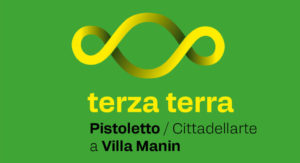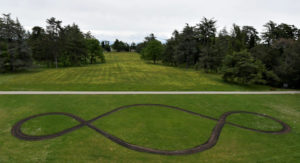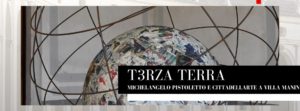Some of Michelangelo Pistoletto‘s most important works, such as the Mirror Paintings, the Venus of Rags, the Sphere of Newspapers, and the Cubic Metre of Infinity, will be artistically connected with the creations of local, Italian and foreign artists, invited to open a dialogue, through their work, with the instances of ethical and social transformation typical of the artist’s work. This will be the heart of the exhibition Terza Terra (Third Earth), which from 25 May 2024 and for the rest of the year will transform Villa Manin di Passariano (Udine) into a detachment of Cittadellarte, “the extended citadel – reads the press release – as a small village Pistoletto gave life to in Biella, his home town”. The exhibition, curated by Guido Comis, director of Villa Manin, for Erpac (Regional Agency for Cultural Heritage), in collaboration with Paolo Naldini, director of Cittadellarte, will bring the authentic spirit of the citadel to the former Doge’s residence, a place where other artists can express themselves on the themes of Pistoletto’s work, a place for debate on the ethics of production, a space for sociality and sharing with the organisations of the territory. “The presence of Michelangelo Pistoletto’s works at Villa Manin,” explains curator Guido Comis, “will be an opportunity to make Passariano a place of creation, discussion and experimentation along the lines of Cittadellarte, but above all to involve the many different souls of the region. The images of the works created and exhibited, but also the ideas that will emerge from the debates and conferences that will be held over the months,”he adds, “will be collected in a publication. More than a traditional catalogue, it will be the diary of a journey towards new opportunities to understand art and its role in society”. Pistoletto’s works exhibited at Villa Manin will dictate the themes of discussion and debate: society, fashion, politics, education, food and agriculture. “The Mirror Paintings,” says Guido Comis, “will allow visitors to enter into a relationship with the characters in the works and share their social situations: the Sphere of Newspapers will introduce the themes of politics and communication, the Venus of the Rags will represent the trait d’union with fashion”.

One of the highlights of the itinerary proposed by Villa Manin will be the Third Paradise, a symbol conceived by Pistoletto with a view to expressing the balanced intertwining of artifice and nature, which will be created in the park of Villa Manin in botanical form on a large scale (50 metres) and will also be the cue to address the issues, now current topics, of agricultural production and food sustainability. A creation ‘in the making’, which will grow thanks to the use of a special vegetable coal that increases soil fertility, Biochar.
“The Third Paradise,” writes Michelangelo Pistoletto, “is the fusion of the first and second paradises. The first is the one in which human beings were totally integrated into nature. The second is the artificial paradise, developed by human intelligence up to the global dimensions reached today through science and technology. The Third Paradise is the third phase of humanity, which is achieved in the balanced connection between nature and artifice; it is the transition to an unprecedented stage of planetary civilisation, indispensable to ensure the survival of the human race. To this end, it is first necessary to re-form the principles and ethical behaviour that guide our common life”.

The exhibition will be accompanied by a programme of conferences called Art of Demopraxy, which will involve public and private organisations, representatives of the productive and agricultural worlds, and of institutions and culture. Villa Manin will thus be a place for the exercise of demopraxy, a neologism coined at Cittadellarte to define the process of social transformation through the direct involvement of all the associations and working groups of a territory. Villa Manin collaborated with the curatorial committee of the UNIDEE Residency Programme – composed of Juan E. Sandoval, artist; Andy Abbott, curator; Alessandra Saviotti, curator; and Beatrice Catanzaro, artist – for the selection of the artists called upon to dialogue with the themes and instances representative of Pistoletto’s works (including Ryts Monet, Caretto – Spagna, Collective Robida, Luigi Coppola, Chiara Sgaramella, Noor Abed, Nico Angiuli, Tiziana and Isabella Pers, PLoT 2021 – Colette Lewis, Marilyn Lennon, Elinor River – and Michele Spanghero), while the programme of conferences accompanying the exhibition was built in collaboration with Giacomo Bassmaji.

“The content of this exhibition proposal,” points out director Paolo Naldini, “intertwines and brings together three layers of content, each of great interest, in an organic and innovative way: starting with the works of Michelangelo Pistoletto as suggestions and indications of an artistic path of research from the 20th century to the present articulated in ‘rooms’; then a selection of artistic practices that deal with the same themes or ‘instances’ selected on the territory of Friuli Venezia Giulia through the network of relations of Erpac – Villa Manin and the network of alumni of the Unidee – Università delle Idee International Residency Program launched at Cittadellarte in 1999; and finally a third layer of innovative devices for activating the territory and its communities starting with the exhibition as an engine of engagement and possibility of transformation. In essence,” Naldini concludes, “the exhibition is grafted onto the collective work of construction, research and creation developed by Cittadellarte over the last 25 years, a quarter of a century of artistic production and research aimed at social transformation, currently recognised as one of the most urgent and significant practices of contemporary art”. The conferences organised around the exhibition will be held in a temporary arena made of ecological and recyclable materials in the central hall of the villa, designed and built by the students of the ISIA Roma Design of Pordenone under the guidance of their teachers. “The institute’s collaborative work,” Comis concludes, “will embody the demopratic spirit promoted by Cittadellarte: the arena will be the fruit of the exchange of ideas and the manual contribution of a community, in this case of students and teachers”.

